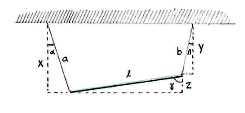Lösung 4.2:8
Aus Online Mathematik Brückenkurs 1
(Unterschied zwischen Versionen)
K (hat „Solution 4.2:8“ nach „Lösung 4.2:8“ verschoben: Robot: moved page) |
|||
| Zeile 1: | Zeile 1: | ||
| - | + | Wir zeichnen drei Dreiecke mit den vertikalen Seiten ''x'', ''y'' und ''z'', wie im Bild. | |
[[Image:4_2_8.gif|center]] | [[Image:4_2_8.gif|center]] | ||
| - | + | Durch die Definition von Kosinus können wir ''x'' und ''y'' berechnen | |
{{Abgesetzte Formel||<math>\begin{align} | {{Abgesetzte Formel||<math>\begin{align} | ||
| Zeile 10: | Zeile 10: | ||
\end{align}</math>}} | \end{align}</math>}} | ||
| - | + | und für ''z'' erhalten wir analog | |
{{Abgesetzte Formel||<math>z=\ell\cos \gamma\,\textrm{.}</math>}} | {{Abgesetzte Formel||<math>z=\ell\cos \gamma\,\textrm{.}</math>}} | ||
| - | + | Außerdem erfüllen die Längen ''x'', ''y'' und ''z'' die Gleichung | |
{{Abgesetzte Formel||<math>z=x-y\,\textrm{.}</math>}} | {{Abgesetzte Formel||<math>z=x-y\,\textrm{.}</math>}} | ||
| - | + | Ersetzen wir ''x'', ''y'' und ''z'' mit unseren Ausdrücken oben, erhalten wir | |
{{Abgesetzte Formel||<math>\ell\cos \gamma = a\cos \alpha -b\cos \beta\,\textrm{,}</math>}} | {{Abgesetzte Formel||<math>\ell\cos \gamma = a\cos \alpha -b\cos \beta\,\textrm{,}</math>}} | ||
| - | + | wo <math>\gamma </math> der einziger unbekannter Variabel ist. | |
Version vom 16:31, 4. Apr. 2009
Wir zeichnen drei Dreiecke mit den vertikalen Seiten x, y und z, wie im Bild.
Durch die Definition von Kosinus können wir x und y berechnen
| \displaystyle \begin{align}
x &= a\cos \alpha\,,\\[3pt] y &= b\cos \beta\,, \end{align} |
und für z erhalten wir analog
| \displaystyle z=\ell\cos \gamma\,\textrm{.} |
Außerdem erfüllen die Längen x, y und z die Gleichung
| \displaystyle z=x-y\,\textrm{.} |
Ersetzen wir x, y und z mit unseren Ausdrücken oben, erhalten wir
| \displaystyle \ell\cos \gamma = a\cos \alpha -b\cos \beta\,\textrm{,} |
wo \displaystyle \gamma der einziger unbekannter Variabel ist.

